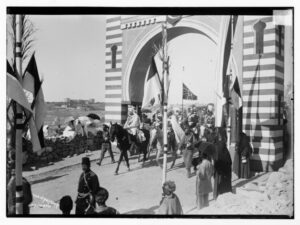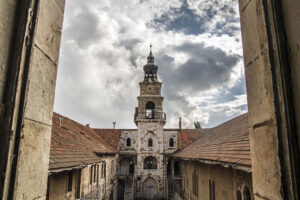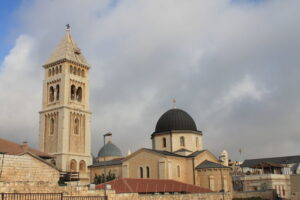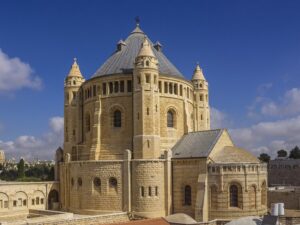Kaiser Wilhelm II of Germany paraded into Jerusalem on 31st October 1898. The Dowager Russian Empress thought the parade was ‘revolting, perfectly ridiculous, disgusting’. Wilhelm had attracted the Dowager’s scorn for trying a bit too hard to make an impression. He may have been the first European head of state to visit Jerusalem since the Crusades. He may have been the ruler of a country less than thirty years old. Nevertheless riding into Jerusalem dressed in a white uniform, a gold veil and a spiked helmet, flanked by German soldiers bearing mock-Crusader banners, is perhaps a bit much. It is a different level of arrogance though to force the Ottoman government to blast an opening in the walls of the Old City because your spiked helmet did not fit through the door at Jaffa Gate. The existing landscape of Jerusalem was altered at the will of a European ruler, for political reasons. No other European country had achieved that. Wilhelm’s procession marked a new era in Jerusalem. Heavy-handed European colonialism had arrived.

KAISER WILHELM II’S ARRIVAL INTO JERUSALEM, 1898
Wilhelm’s overbearing approach is all the more stark because the German presence in Jerusalem was the lightest of the Europeans there. No German architectural statement existed before 1890 to compare with the French Notre Dame, the Russian Compound or the British Christ Church. The German buildings looked to integrate more closely into the existing landscape of Jerusalem. The red-tiled roofs of the houses in the German Colony do mark them out as European. Yet the houses are rarely more than two stories and are clearly meant to resemble local houses with exterior staircases and rounded arch windows with shutters. Construction began on this site, southwest of the Old City, in 1873 and the architect for many of the buildings was a German, Conrad Schick. He applied the same principles to his own house that he built fifteen minutes walk northwest of the Old City. It was completed in 1889 and shares the same red-tiled roof offset by predominantly local features. The other major German building constructed before 1890 was the Schneller Compound. This orphanage is more German in character: the Fraktur script inscription on the front is particularly striking. Nevertheless it still does not compare to the British, French and Russian statements in size. It is also considerably further north and so the Old City is out of sight. None of these buildings appear to be engaged in the same competition as the other Europeans and as a result, they incorporate more local elements.

THE SCHNELLER COMPOUND
A unified German state did not exist before 1871 and Otto von Bismarck was too busy establishing Imperial Germany after unification to try competing with the more powerful British, French and Russians in Jerusalem. Religious dreams played a role too in the lack of state sponsorship for buildings in Jerusalem. King Frederick William IV dreamt of a unified global church, Protestant in character, and focused on Jerusalem. A building was not going to initiate the return of Christ but a joint bishopric between the English and the Germans might. King William donated more money than the English towards the establishment of such an institution in 1841, even though the English effectively controlled the bishopric. The other religious dream that mitigated against the German government financing buildings was the dream of the Templers. Their dream was also of the return of Christ but they were a grassroots movement that threatened to split the Lutheran church. As a result, they were expelled from the church and went to live in Jerusalem. They built the German Colony. The German government was not going to spend money though on a heretical sect.
All changed with Wilhelm. He was the ruler of united Germany, spending money on buildings in direct competition with European rivals, in the pursuit of an ideology that had nothing to do with the Last Days. Wilhelm financed four buildings that he intended to be symbols of the wide reach of German culture, to stake a claim for German imperialism in the ‘holy land’, and to display a vision of new Germany still touch with its Christian roots. These buildings were the Church of the Redeemer in the Old City completed in 1897, the Abbey of the Dormition just south of the Old City and built in 1901, St Paul’s hospice to the north of the Old City constructed in 1908, and the Augusta Victoria hospital and church complex on the Mount of Olives and completed in 1914. All are conspicuous marks on Jerusalem’s landscape. The Church of the Redeemer, the Abbey of the Dormition and Augusta Victoria are all built in an ecclesiastical, neo-Romanesque style that had become the state style of the new Imperial Germany. The tall pointed towers, the thick, featureless walls, the rounded arches were chosen because they conveyed solidity, weight and an implied connection with a German medieval past. St Paul’s Hospice displays similar qualities through its resemblance to a Crusader castle, and its embrace of secular neo-Romanesque characteristics. This was a centralised project. The style is consistent across the buildings, regardless of location, function or religious denomination (the Church of the Redeemer is Lutheran, the Abbey of the Dormition Catholic). The aim was to mark Imperial Germany’s arrival as a cultural and diplomatic force. Jerusalem was where the existing European powers had outsourced their rivalries and it was only natural that Wilhelm joined in.

THE CHURCH OF THE REDEEMER
Wilhelm joined, through the traditional means, the game of European politics in Jerusalem. He built churches, hospitals and pilgrim hostels. Yet his entry changed the game. The British, French and Russians had established presences in Jerusalem because they wanted influence in the Ottoman Empire, as part of their rivalries against each other. Wilhelm did not want just influence. He rode into Jerusalem in 1898 as an extension of his trip to Istanbul, the capital of the Ottoman Empire. He had visited the capital to bend the Ottomans to his will. Imperial Germany needed an empire, the other Europeans had already taken much of the globe, the Ottoman empire looked primed for an informal takeover. Wilhelm achieved the first step in 1903 when he won the right to build a railway from Berlin to Baghdad, and thus extending German power deep into Ottoman lands. He also was driving the British, French and Russians together into the Triple Entente. His procession into Jerusalem and his building projects had, in a certain way, set off the train of events that led to World War One. During that war, another European paraded into Jerusalem. He and his military government of the city would make much more widespread changes to the existing landscape of Jerusalem, than Wilhelm did. What Wilhelm started, General Allenby and the British continued.

THE ABBEY OF THE DORMITIAN




